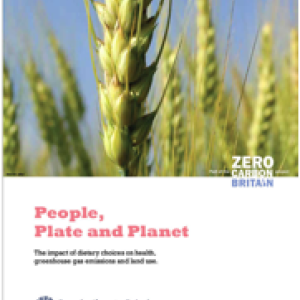
The Centre for Alternative Technology (CAT) has launched a new report on sustainable diets - People, Plate and Planet, describing dietary choices that can reduce greenhouse gas emissions and pressures on land. The report considers nutrition, GHG emissions and land use and states that the most significant impact on these areas comes from what we eat, not where it is from or how much packaging there is around it.
Its “findings” sections state the following:
“Greenhouse gas (GHG) emissions relating to our diets, and the amount of land required to produce the foods for each, can vary significantly. Making changes to what, and how much, we eat can help lower these emissions and the amount of land required to feed the UK population. In fact, the types and quantities of foods we consume have the greatest impact on emission reductions and the amount of land required for agriculture, and changes to the current average diet in the UK should be encouraged. Shifting the diet of the UK more in line with health recommendations would have the positive benefit of reducing GHG emissions and freeing up land for other uses. Our analysis shows that kilocalorie and protein requirements can be easily met with a variety of different diets, and that people can still eat a good balance of foods on a low carbon diet. Eliminating animal (both meat and dairy) products from the diet altogether is the most effective way of reducing GHG emissions and land use, but these can still be lowered significantly with less dramatic changes in the foods that we eat. Buying food produced in the UK – especially when buying meat products, fruits and vegetables – and reducing food waste should also be encouraged to reduce GHG emissions and land use relating to the food we eat, but have less of an overall effect than switching what it is we eat.”
The report is launched together with the online tool Laura's Larder, that aims to help people make more healthy and sustainable dietary choices. The tool is designed to help you calculate the impact of your diet and suggest changes that are healthy and sustainable. More specifically, it allows you to put in what you eat, and shows what the nutritional qualities and deficits are, while also calculating its GHG footprint. The tool was developed as a part of CAT's earlier research into healthy, sustainable diets in the Zero Carbon Britain project.
Citation
Blake, L., 2014, People, Plate and Planet - The impact of dietary choices on health, greenhouse gas emissions and land use, CAT.
Read the full report here and view the tool Laura's Larder here. You can also see another report from Zero Carbon Britain on how food and diets fit into a wider decarbonisation scenario for the UK here. For other carbon footprinting tools, see our research library sections on this, here and here.
Read more about sustainable diets in FCRN's latest discussion papers What is a sustainable, healthy diet here and Changing what we eat: A call for research & action on widespread adoption of sustainable healthy eating here. See also the result page for a search on sustainable healthy diets on the FCRN website here.







Post a new comment »